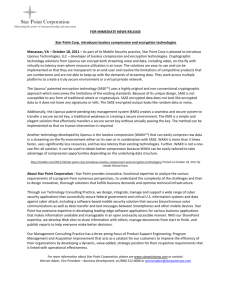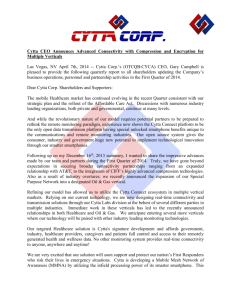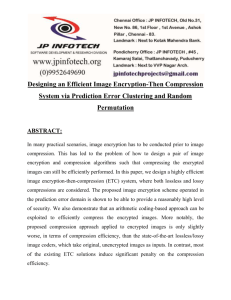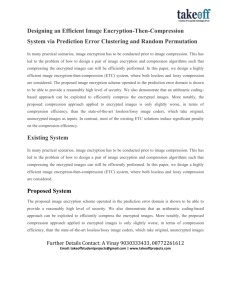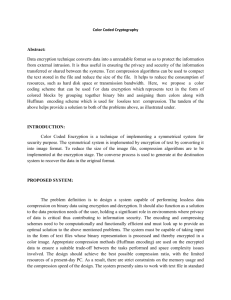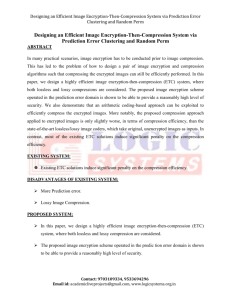UPONUS_CIFF_CRYPTOLOGICA_comparison
advertisement
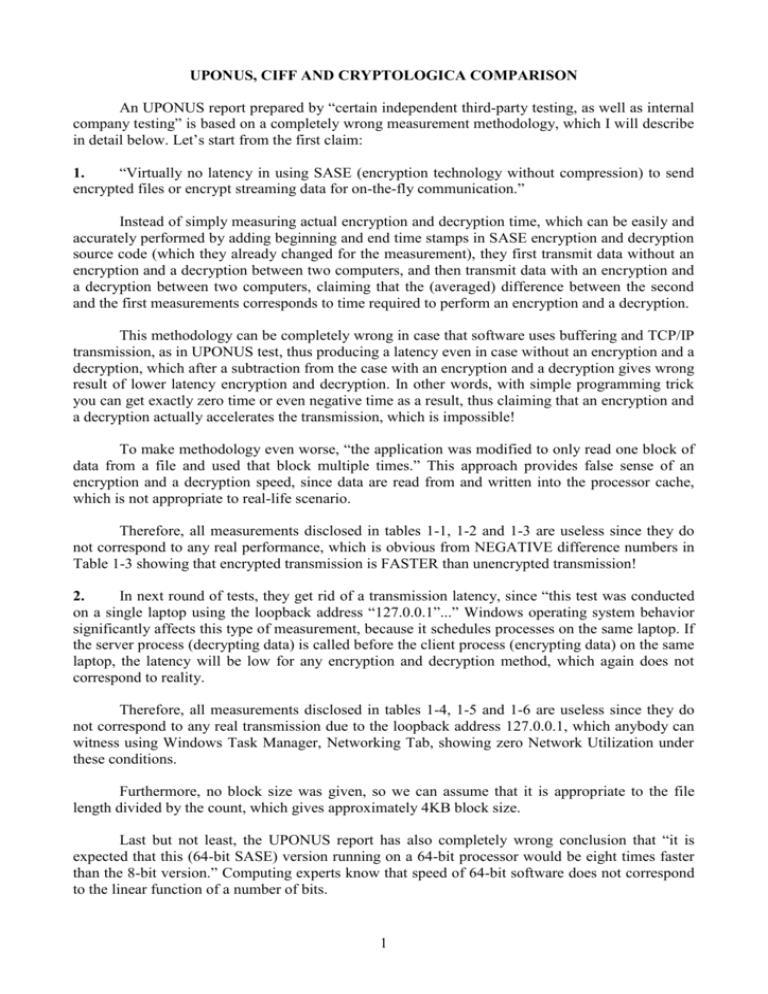
UPONUS, CIFF AND CRYPTOLOGICA COMPARISON An UPONUS report prepared by “certain independent third-party testing, as well as internal company testing” is based on a completely wrong measurement methodology, which I will describe in detail below. Let’s start from the first claim: 1. “Virtually no latency in using SASE (encryption technology without compression) to send encrypted files or encrypt streaming data for on-the-fly communication.” Instead of simply measuring actual encryption and decryption time, which can be easily and accurately performed by adding beginning and end time stamps in SASE encryption and decryption source code (which they already changed for the measurement), they first transmit data without an encryption and a decryption between two computers, and then transmit data with an encryption and a decryption between two computers, claiming that the (averaged) difference between the second and the first measurements corresponds to time required to perform an encryption and a decryption. This methodology can be completely wrong in case that software uses buffering and TCP/IP transmission, as in UPONUS test, thus producing a latency even in case without an encryption and a decryption, which after a subtraction from the case with an encryption and a decryption gives wrong result of lower latency encryption and decryption. In other words, with simple programming trick you can get exactly zero time or even negative time as a result, thus claiming that an encryption and a decryption actually accelerates the transmission, which is impossible! To make methodology even worse, “the application was modified to only read one block of data from a file and used that block multiple times.” This approach provides false sense of an encryption and a decryption speed, since data are read from and written into the processor cache, which is not appropriate to real-life scenario. Therefore, all measurements disclosed in tables 1-1, 1-2 and 1-3 are useless since they do not correspond to any real performance, which is obvious from NEGATIVE difference numbers in Table 1-3 showing that encrypted transmission is FASTER than unencrypted transmission! 2. In next round of tests, they get rid of a transmission latency, since “this test was conducted on a single laptop using the loopback address “127.0.0.1”...” Windows operating system behavior significantly affects this type of measurement, because it schedules processes on the same laptop. If the server process (decrypting data) is called before the client process (encrypting data) on the same laptop, the latency will be low for any encryption and decryption method, which again does not correspond to reality. Therefore, all measurements disclosed in tables 1-4, 1-5 and 1-6 are useless since they do not correspond to any real transmission due to the loopback address 127.0.0.1, which anybody can witness using Windows Task Manager, Networking Tab, showing zero Network Utilization under these conditions. Furthermore, no block size was given, so we can assume that it is appropriate to the file length divided by the count, which gives approximately 4KB block size. Last but not least, the UPONUS report has also completely wrong conclusion that “it is expected that this (64-bit SASE) version running on a 64-bit processor would be eight times faster than the 8-bit version.” Computing experts know that speed of 64-bit software does not correspond to the linear function of a number of bits. 1 3. “Other third-party SASE speed tests show low resource utilization and speed of up to 25 MB/s using the 3-round variant version, and 15 MB/s with the 11-round variant version of SASE using a 2.2 GHz processor with 2GB of RAM on a Windows based machine.” “Tested key sizes were: 32B (256-bit), 64B (512-bit), 512B (4096-bit) and 1,024B (8192-bit).” For more details about UPONUS algorithms, you can download U.S. patent No. 7,382,878B2 and U.S. patent application No. 2003016820, which disclose a block cipher in a stream mode combined with a lossless compression: http://home.etf.rs/~proka/CRYPTO/US7382878B2.pdf http://home.etf.rs/~proka/CRYPTO/US2003016820A1.pdf 256-bit key AES encryption method in CTR mode, which is much more secure than ECB and CBC modes mentioned in the UPONUS report, encrypts or decrypts data with a speed of 70 MB/s using a single core of 2.66 GHz processor with 2GB of RAM and Windows operating system. 1920x1080x30fps HD CIFF compression, streaming and decompression with 256-bit key AES encryption method in GCM-AEAD mode (IP-packet mode with authentication), which is recommended for top secret government data, has negligible total latency of 1 frame (0.033 s) for CIFF encoder plus CIFF decoder, while additional latency due to 256-bit AES-GCM-AEAD is undetectable, i.e. below the measurement error. This can be easily proven by compressing video file with incremented frame numbers and displaying these numbers before CIFF compression and 256-bit AES-GCM-AEAD encryption on the first PC and comparing these numbers with the received numbers displayed after 256-bit AESGCM-AEAD decryption and CIFF decompression on the second PC. 4096-bit key CRYPTO LOGICA encryption technology without any optimization and without any multithreading support encrypts or decrypts data with a speed between 142 MB/s and 569 MB/s using a single core of 2.66 GHz processor with 2GB of RAM and Windows operating system, which is several times faster than 256-bit AES and order of magnitude faster than SASE: http://home.etf.rs/~proka/CRYPTO/CRYPTOLOGICA16MB.ppt TYPE B B B B H H S ENCRYPTION METHOD KEY LENGTH [bits] BLOCK [bits] SHORT LONG MIN MAX SBC Short Block Cipher 256 2048 128 LBC Long Block Cipher 512 4096 256 UBC Ultimate Block Cipher 384 2048 256 UBE UBC Extended 768 4096 256 SHC Short Hybrid Cipher 256 2048 128 HES Hybrid Encryption Solution 384 2048 256 STE Stream Extended Cipher 2048 2048 ∞ Therefore, the combination of CIFF and CRYPTO LOGICA will provide even better results than the combination of CIFF and AES-GCM-AEAD, which are already significantly better WAKit, CleanColor and SASE. 2 T Y ALGORITHM OWNER P E B AES (Ref) PUBLIC KEY LENGTH [bits] BLOCK SIZE [bits] ENC/DEC SPEED [Mbit/s] ALG SPEED AES SPEED 256 128 73 1 B B B B B B AES CTR SASE-11 SASE-3 SBC LBC UBC PUBLIC UPONUS UPONUS CRYPTO LOGICA CRYPTO LOGICA CRYPTO LOGICA 256 256..8192 256..8192 2048 4096 2048 128 ? ? 128 256 256 70 15 25 178 205 213 0.96 B H H H S UBE SHC HES 1024 HES 2048 STE CRYPTO LOGICA CRYPTO LOGICA CRYPTO LOGICA CRYPTO LOGICA CRYPTO LOGICA 4096 2048 1024 2048 4096 256 128 256 256 4096 142 152 341 179 569 1.95 2.09 4.68 2.45 7.79 0.21 0.34 2.44 2.81 2.92 4. “Strength of SASE Encryption” was tested using Diehard Randomness Test, while strength of CRYPTO LOGICA methods was tested using much more comprehensive NIST STS 2.1 tests: http://csrc.nist.gov/groups/ST/toolkit/rng/documentation_software.html 5. WAKit - mathematically lossless compression does not make sense for already losslessly or lossy compressed video (such as .mpg and .wmv files used during measurement), since most of redundancy was already removed by previous compression process, so there is practically nothing that can be further compressed. That’s why the UPONUS report measured only an encryption and not a compression on already compressed files (page 3). On the other hand, CIFF can further compress already compressed files in order to decrease their size or decrease necessary bitrate for their transmission or decrease transmission time. CIFF can compress very noisy 252MB declassified 9506x9294x24bpp Bae BMP image with the following compression ratios on a single CPU core: No. 1 2 3 4 5 Compression type mathematically lossless visually lossless visually lossless very good quality good quality Compression Ratio 2.28:1 11.88:1 27.83:1 62.63:1 143.51:1 3 Compression [s] 10.18 5.76 4.17 2.91 2.09 Decompression [s] 10.87 6.05 4.07 2.84 1.92 CIFF and WinZip WZZIP / WZUNZIP results on various BMP images are: BMP image size [kB] Anemone 988 Baboon 769 Bae 258,853 City 74,807 Bike 15,361 Coffee 9,113 Connery 9,217 Dew 6,076 Formula1 704 Happy 15,398 Hats 1,153 Island 1,153 Lena 769 Monarch 1,153 Panorama 59,261 Peppers 769 Sail 1,153 Tulips 1,153 Woman 15,361 BMP No. image name 1 2 3 4 5 6 7 8 9 10 11 12 13 14 15 16 17 18 19 Compression [s] Decompression [s] CIFF 0.04 0.04 10.26 2.92 0.65 0.32 0.39 0.24 0.03 0.59 0.05 0.05 0.04 0.05 2.63 0.03 0.05 0.05 0.63 CIFF WZUNZIP 0.05 0.07 0.04 0.06 10.80 16.92 2.97 4.93 0.69 1.17 0.35 0.53 0.41 0.60 0.26 0.41 0.03 0.04 0.64 0.89 0.05 0.07 0.05 0.07 0.04 0.06 0.05 0.07 2.68 4.03 0.04 0.05 0.05 0.07 0.05 0.07 0.67 0.99 WZZIP 0.08 0.07 18.07 5.12 1.25 0.58 0.61 0.43 0.05 0.95 0.08 0.08 0.07 0.08 4.21 0.07 0.08 0.08 1.05 Relative compressed file size / BMP image size CIFF ZIP 0.63087 0.91817 0.78013 0.95432 0.43813 0.80285 0.42744 0.54761 0.53760 0.67942 0.31380 0.64995 0.50675 0.80888 0.44583 0.76560 0.35042 0.54325 0.40056 0.62744 0.39451 0.48895 0.40705 0.50162 0.58881 0.93294 0.42076 0.71973 0.57654 0.82620 0.47323 0.86254 0.48129 0.80768 0.45682 0.85180 0.50918 0.73586 NOTICE: Smaller compression and decompression time are better. Smaller relative compressed file size is better. CIFF provides SIGNIFICANTLY SMALLER lossless compressed file size than ZIP with significantly shorter compression and decompression time even without using multiple cores and multithreading support, since all aforementioned measurements have been done for a single core and single thread CIFF. On the other hand, WAKit provides NEGLIGIBLE SMALLER lossless compressed file size than ZIP with significantly shorter compression time, according to Table 2 in the UPONUS report. Furthermore, CIFF is faster than WAKit according to the last table in the UPONUS report, since CIFF can mathematically lossless compress 74MB file in less than 3 s, while WAKit requires 6 s. CIFF can mathematically lossless compress 15MB file in 0.6 s, while WAKit requires 1 s, etc. 6. CleanColor - visually lossless compression also does not make sense for already lossy compressed video (such as .mpg and .wmv files used during measurement), since almost all redundancy was already removed by previous compression process, so there is practically nothing that can be further compressed. That’s why the UPONUS report didn’t cover CleanColor compression of already compressed files. 4 7. Predictor - the modification of WAKit, which is also not covered by the UPONUS report. I would not comment on a speculative estimation of performance provided in the UPONUS report, which is always worse than readily available CIFF performance. CONCLUSIONS In a nutshell, as a conclusion, it is obvious that: a) SASE provides much slower encryption speed than AES-GCM-AEAD and AES-CTR, while CRYPTO LOGICA is several times faster than AES in any mode and order of magnitude faster than SASE, with other advantages emphasized in bold numbers. No. 1 2 3 4 5 6 7 8 9 10 11 12 13 14 15 16 17 18 19 20 21 22 23 24 Features Brutal force security Linear cryptoanalysis security Differential cryptoanalysis security Security against computing development Security against weak keys Security against zero key Security against similar keys Family of customized algorithms Adjustable parameters in algorithms Parameter change by the user Unknown algorithm for unauthorized Key generator Latency (cipher + decipher) Cipher (encrypting) speed Decipher (decrypting) speed Processing throughput required Power consumption Heat dissipation Memory size Memory bandwidth Weight of supporting hardware Size of supporting hardware Cost of supporting hardware Integer arithmetic CRYPTO LOGICA YES YES YES YES YES YES YES YES YES YES YES YES LOW HIGH HIGH LOW LOW LOW LOW LOW LOW LOW LOW YES SASE YES YES YES YES YES YES YES NO NO NO NO NO LOW LOW LOW HIGH HIGH HIGH MEDIUM HIGH HIGH HIGH HIGH YES b) WAKit provides twice faster mathematically lossless compression with similar compression ratio (similar compressed file size) in comparison with ZIP method, while CIFF provides twice faster mathematically lossless compression than WAKit with much better compression ratio (smaller compressed file size) in comparison with ZIP method, using single core and single thread during compression and decompression of still images. In case of video, CIFF is proportionally faster due to the utilization of multiple cores and multithreading. c) In addition to mathematically lossless compression, CIFF provides visually lossless (up to 30:1) and lossy compression up to 4,000:1, which is unattainable by WAKit, even with CleanColor and Predictor modifications, and even with UPONUS speculative estimations. d) Furthermore, CIFF has many features described in white papers in detail, which are completely unattainable by WAKit, even with CleanColor and Predictor modifications: 5 http://home.etf.rs/~proka/CIFF_Overview.pdf e) As a conclusion, CIFF is future proof but available today compression and decompression method which besides quality for a given bitrate provides the complete set of features while supporting any resolution now and in the future. No. 1 2 3 4 5 6 7 8 9 10 11 12 13 14 15 16 17 18 19 20 21 22 23 24 25 26 27 28 29 Features Mathematically lossless compression Visually lossless compression (up to 6:1) Visually lossless compression (up to 30:1) Medium lossy compression (up to 400:1) Very lossy compression (up to 4,000:1) I-frame codec IP-frame codec Maximum I-frame compression ratio Estimated I-frame compression ratio Maximum IP-frame compression ratio Estimated IP-frame compression ratio Transcoding of already compressed data Spatial (resolution) scalability Quality (processing reduction) scalability Temporal (frame dropping) scalability Latency (encoder + decoder) Error resilience Compression (encoding) speed Decompression (decoding) speed Processing throughput required Power consumption Heat dissipation Memory size Memory bandwidth Weight of supporting hardware Size of supporting hardware Cost of supporting hardware Integer arithmetic Multiplication or division CIFF YES YES YES YES YES YES YES 150:1 300:1 4,000:1 10,000:1 YES YES YES YES MINIMAL (1-frame) HIGH HIGH HIGH LOW LOW LOW LOW LOW LOW LOW LOW YES NO WAKit YES NO NO NO NO YES NO 3:1 9:1 N/A N/A NO NO NO YES N/A N/A MEDIUM MEDIUM MEDIUM MEDIUM MEDIUM MEDIUM HIGH MEDIUM MEDIUM MEDIUM YES ? CleanColor NO YES NO NO NO YES NO 6:1 18:1 N/A 150:1 NO NO NO YES N/A N/A MEDIUM MEDIUM MEDIUM MEDIUM MEDIUM MEDIUM HIGH MEDIUM MEDIUM MEDIUM YES ? In addition to that, CIFF codec can run on existing assets. For example, CIFF supports UDTV (3840x2160x25fps) compression and decompression on 4-year old Core2Duo notebooks, which means that existing hardware can be used in years to come by simple software implementation of CIFF codec, while new devices can additionally benefit from low-power software implementation or ultra-low power hardware implementation of CIFF codec. 6
